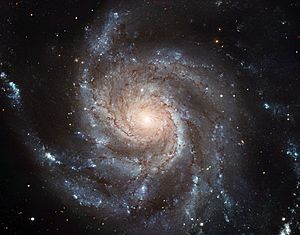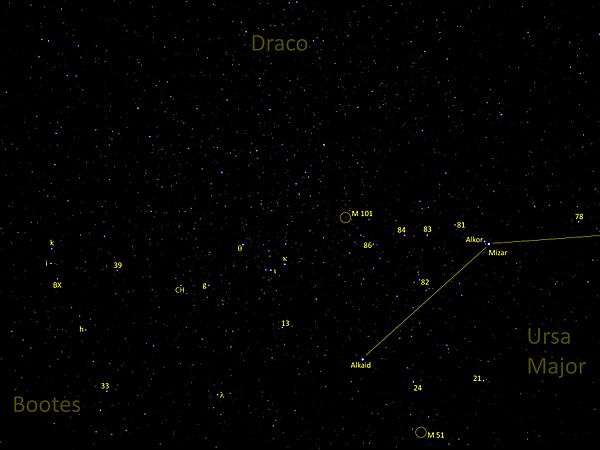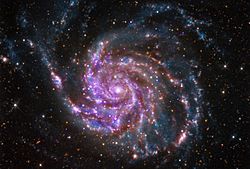Pinwheel Galaxy facts for kids
Quick facts for kids Pinwheel Galaxy |
|
|---|---|

The Pinwheel Galaxy, as taken by Hubble Space Telescope
|
|
| Observation data (J2000 epoch) | |
| Constellation | Ursa Major |
| Right ascension | 14h 03m 12.6s |
| Declination | +54° 20′ 57″ |
| Redshift | 0.000804 |
| Helio radial velocity | 241 ± 2 km/s |
| Distance | 20.9 ± 1.8 Mly (6.4 ± 0.5 Mpc) |
| Type | SAB(rs)cd |
| Number of stars | 1 trillion (1012) |
| Apparent dimensions (V) | 28′.8 × 26′.9 |
| Apparent magnitude (V) | 7.9 |
| Other designations | |
| Messier 101, M101, NGC 5457, UGC 8981, PGC 50063, Arp 26 | |
| See also: Galaxy, List of galaxies | |

The Pinwheel Galaxy (also known as Messier 101 or M101) is a large spiral galaxy that we see face-on from Earth. It is located about 21 million light-years away in the constellation Ursa Major, also known as the Great Bear.
This galaxy was first discovered by Pierre Méchain in 1781. He shared his discovery with Charles Messier, who added it to his famous list of celestial objects. In 2006, NASA and the European Space Agency released an amazing, super-detailed picture of the Pinwheel Galaxy. It was the biggest and clearest image of a galaxy ever taken by the Hubble Space Telescope at that time! To create this one picture, scientists combined 51 different photos.
Contents
Discovering the Pinwheel Galaxy
Pierre Méchain, the person who first found the galaxy, described it as a "cloud without stars, very dark and quite big." He said it was hard to see clearly, especially when using certain telescope tools.
Later, in 1784, William Herschel looked at the galaxy with his powerful telescopes. He thought it looked "mottled," like it was made of many tiny stars that his telescope couldn't quite separate. He believed that even stronger telescopes would eventually show these individual stars.
In the 1800s, Lord Rosse used a huge, 72-inch-wide telescope to observe the Pinwheel Galaxy. He was the first to notice and draw its beautiful spiral arms in detail.
Even though you can spot the Pinwheel Galaxy with binoculars or a small telescope, seeing its spiral shape is tricky. To truly see its arms without a camera, you need a very large telescope, a very dark sky away from city lights, and a special eyepiece that shows a wide view.
What the Pinwheel Galaxy is Made Of
The Pinwheel Galaxy is truly enormous! It measures about 170,000 light-years across. To give you an idea, our own galaxy, the Milky Way, is about 100,000 to 120,000 light-years wide. The Pinwheel Galaxy is home to an incredible number of stars – about a trillion (that's 1,000,000,000,000!) stars!
Most of its mass is in its flat disk, which is like 100 billion times the mass of our Sun. It also has a small central bulge, like a tiny bump in the middle, which is about 3 billion times the mass of our Sun. Its features are similar to those of the famous Andromeda Galaxy.
Star-Forming Regions
The Pinwheel Galaxy has many bright areas called H II regions. These are huge clouds of gas where new stars are being born. H II regions glow brightly because they are lit up by many extremely hot and bright young stars. These powerful stars can even create giant "superbubbles" of gas. In a study from 1990, scientists found 1,264 of these star-forming regions in the galaxy! Three of them are so big and bright that they have their own names: NGC 5461, NGC 5462, and NGC 5471.
Galaxy Shape and Interactions
The Pinwheel Galaxy isn't perfectly round or symmetrical. This is because it's being pulled by the gravity of other smaller galaxies nearby. These gravitational tugs squeeze the gas between the stars, which then causes even more new stars to form in the Pinwheel's spiral arms. We can see this new star formation clearly in ultraviolet images.
In 2001, scientists found a powerful X-ray source in the Pinwheel Galaxy called M101 ULX-1. This source is brighter than any single star but not as bright as a whole galaxy. Later observations showed that M101 ULX-1 is likely an X-ray binary. This means it's a system where a black hole is pulling material from a nearby star. What's interesting is that this black hole is only about 20 to 30 times the mass of our Sun, but it's pulling in material much faster than scientists expected!
Scientists believe the Pinwheel Galaxy has about 150 globular clusters. These are tight groups of hundreds of thousands of old stars, all held together by gravity. This is about the same number of globular clusters found in our own Milky Way galaxy.
Neighboring Galaxies
The Pinwheel Galaxy has six main companion galaxies that orbit around it. These include NGC 5204, NGC 5474, NGC 5477, NGC 5585, UGC 8837, and UGC 9405. As mentioned before, the gravitational pull from these smaller galaxies might be why the Pinwheel Galaxy has such a beautiful and clear spiral pattern. The Pinwheel Galaxy has likely even pulled on and changed the shape of one of its companions, NGC 5474. Together, these galaxies form what is known as the M101 Group.
Supernovae and Luminous Red Novae
The Pinwheel Galaxy has been a busy place for cosmic explosions! Scientists have recorded several supernovae (exploding stars) and one luminous red nova (a different type of star explosion) happening within it:
- SN 1909A: Discovered in January 1909, this supernova became quite bright.
- SN 1951H: This one was seen in September 1951.
- SN 1970G: Discovered in July 1970, it was also very bright.
- SN 2011fe: On August 24, 2011, a Type Ia supernova was found. This type of supernova happens when a white dwarf star explodes. It became very bright, even visible with small telescopes.
- M101 OT2015-1: On February 10, 2015, a luminous red nova was discovered. This is a powerful burst of light from a star that is merging with another star.
- SN 2023ixf: On May 19, 2023, a Type II supernova was discovered. This type of supernova occurs when a massive star runs out of fuel and collapses.
-
The Type Ia supernova SN 2011fe as seen in August 2011.
-
The Type II supernova SN 2023ixf as seen in May 2023.
See also
 In Spanish: Galaxia espiral M101 para niños
In Spanish: Galaxia espiral M101 para niños
- List of Messier objects
- Messier 74 – a similar face-on spiral galaxy
- Messier 83 – a similar face-on spiral galaxy that is sometimes called the Southern Pinwheel Galaxy
- Messier 99 – a similar face-on spiral galaxy
- Triangulum Galaxy – another galaxy sometimes called the Pinwheel Galaxy




